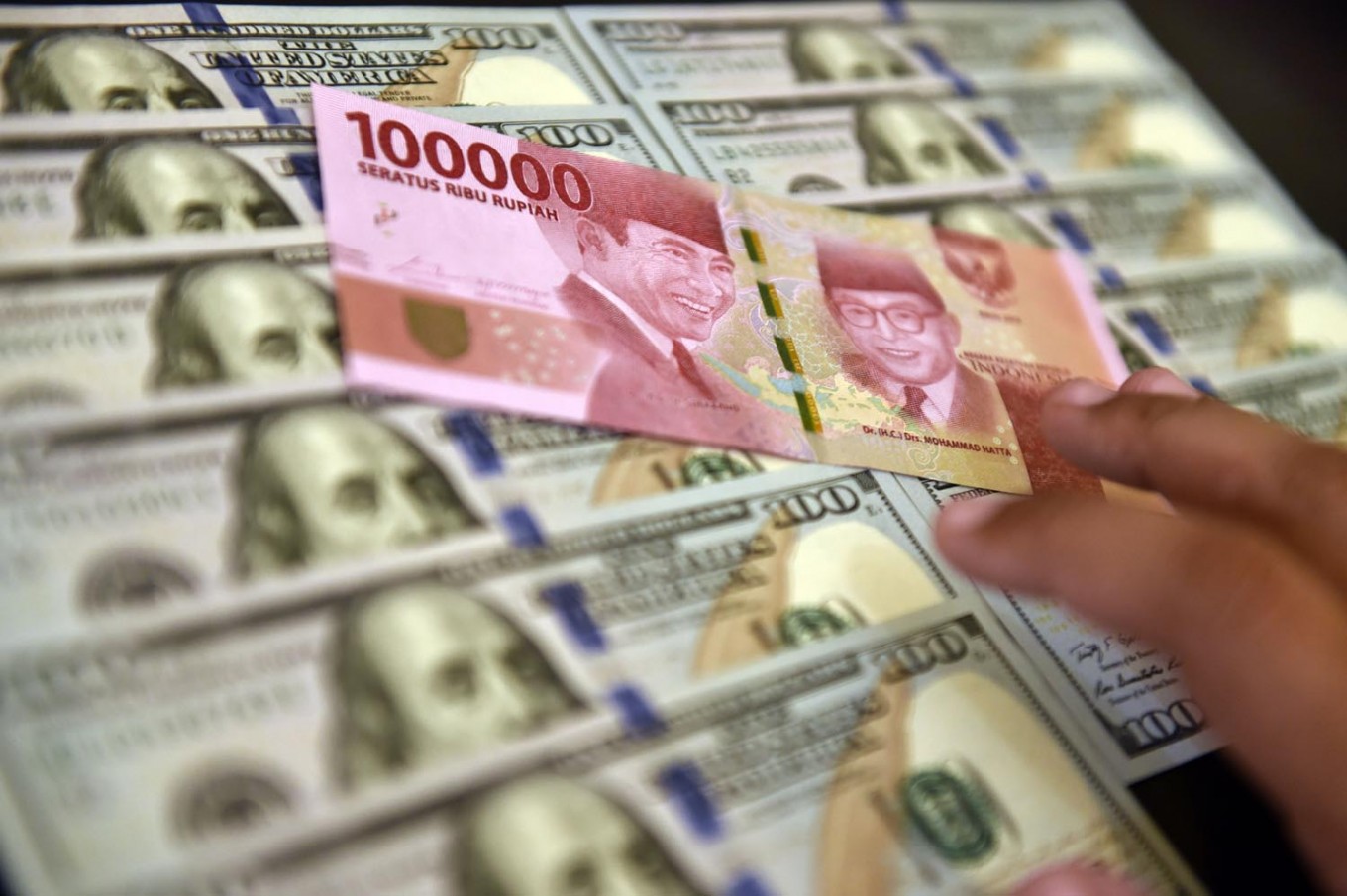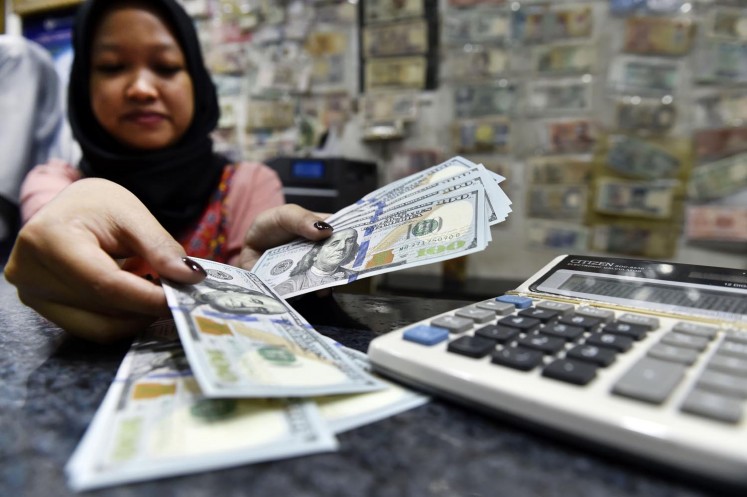Popular Reads
Top Results
Can't find what you're looking for?
View all search resultsPopular Reads
Top Results
Can't find what you're looking for?
View all search resultsQ&A: How low can the rupiah go?
Deciding on what currencies to keep may become a new headache for businesspeople these days.
Change text size
Gift Premium Articles
to Anyone
T
he rupiah fell to a two-decade low on Tuesday to Rp 14,940 against the US dollar as negative sentiments continued to dominate the emerging markets, including Indonesia, at a time when liquidity has tightened globally.
The current exchange rate was higher when compared to the beginning of the year, when the rupiah was being traded at between Rp 13,300 and Rp 13,400 per US dollar and it was already higher than the macroeconomic assumptions in the 2018 state budget, which assumed the rupiah’s exchange rate at Rp 13,400 per US dollar on average this year.
In fact, the current level has invited comparisons to the exchange rate last seen during the height of the 1998 financial crisis when the rupiah depreciated sharply as foreign capital poured out of the Southeast Asian region.
Here’s your guide to understand the inner workings of the rupiah’s recent depreciation.
Why does the rupiah depreciate?
There are two factors that help to explain the rupiah’s demise against a stronger US dollar. From the external side, the tightening policy undertaken by the United States Federal Reserve’s planned interest rate hike is a huge factor influencing the weakening of the rupiah as well as other emerging markets currencies.
The Fed, buoyed by positive macroeconomic data from the US, has stepped up its stance to manage inflation. It has so far raised its key rate twice this year and is expected to hike it two more times before the end of the year.
The Fed’s stance has prompted readjustments of capital flows as portfolio investors dumped emerging markets assets in search of higher yields offered in developed economies.
For Indonesia, this means foreign investors chose to sell the rupiah for the greenback, or selling their sovereign bonds as they seek assets that will produce better yields. Aside from the Fed, the European Central Bank (ECB) is also set to end its bond-buying program known as quantitative easing by December.
From the domestic side, Indonesia is currently running on a current account deficit (CAD), which has widened in the second quarter this year to US$8 billion -- equal to 3 percent of the gross domestic product (GDP) -- from the $5.7 billion that was recorded in the previous quarter.
Bank Indonesia (BI) says Indonesia’s CAD is still at a safe level if it does not breach 3 percent against GDP.
The current account is the widest measurement of international trade in goods and services of one country.
A CAD indicates a country is spending beyond its means in terms of foreign exchange liquidity, therefore leaving it vulnerable to external shocks as it needs to cover the deficit with foreign capital inflows from portfolio or foreign direct investments, which dried up for emerging markets due to the Fed’s tightening policy.
The government has said the CAD was the Achilles heel of the Indonesian economy at the moment from otherwise positive macroeconomic indicators such as manageable inflation and sustained economic growth at around 5 percent over the past few years.
Does the situation compare to the 1998 financial crisis?
While the nominal value of the currency compared to the US dollar has invited comparisons to the rate seen 20 years ago, the rate of the rupiah’s weakening may tell a different story.
It has lost its value by 11 percent year-on-year (yoy) in September, from Rp 13,345 against the US dollar in September last year to the Rp 14,815 level seen this month.
Compare that to a whopping 254 percent depreciation yoy in September 1998, when the rupiah was valued at Rp 3,030 per US dollar in September 1997 before sharply depreciating a year later to Rp 10,725.
If the current rupiah depreciation was calculated using the sharp depreciation rate like in 1998, the currency should be trading at Rp 47,241 per US dollars by current valuation.
Other data also pointed to more robust economic fundamentals in 2018 when compared to 1998.
Foreign exchange reserves, for example, were recorded at $118.3 billion as of July 2018 in contrast to $23.61 billion back in 1998.
Inflation was also recorded at a manageable level of 3.2 percent yoy in August, still within the government’s target and in stark contrast to the 78.2 percent yoy inflation in August 1998.
Meanwhile, the GDP expanded by 5.27 percent yoy during the second quarter this year, while in the second quarter of 1998 the economy contracted by 13.34 percent.
For some time, the rupiah has been under pressure from the tightening of the United States monetary policy. (Antara/Puspa Perwitasari)What are the authorities doing to halt the depreciation?
Stability is the key guidance of BI’s monetary policy as it has so far hiked its key rate -- Seven-days reverse repo rate -- by 125 basis points to date to bring the rate to 5.5 percent currently.
The central bank maintained a hawkish stance of its monetary policy as it looks to safeguard the rupiah from wild volatilities, while the rate hike was also intended to maintain the competitiveness of domestic financial markets, which it hoped could attract foreign capital inflows to the country.
BI has also heavily intervened in the secondary bonds market and foreign exchange market to stabilize the rupiah, a policy known as a dual intervention policy.
For the government’s part, it has been hard at work to implement several measures to cut the CAD.
It has recently issued a new regulation that will take effect next week. The regulation aims to curb the importation of 1,147 consumer goods that have locally produced equivalents or deemed to have minimal added-value to the economy, raising its withholding import tax of certain goods by three or four times when compared to the previous regulation.
The government has recently expanded the use of 20 percent blended biodiesel (B20) to the non-Public Service Obligation (PSO) sector, a policy that was intended to reduce fuel imports. The policy is expected to save up to $2.3 billion.
What’s at stake if the rupiah keeps depreciating?
Simply put, the most direct effect of the rupiah’s depreciation is a higher price for imported goods, which will soar higher if the government’s latest withholding import tax rule comes into effect.
It means that consumers of imported electronics such as smartphones or laptops may see price increases today when compared to price levels seen at the beginning of the year.
Producers that have been reliant on imported raw materials or intermediary goods have also been hit hard by the depreciation of the rupiah as they have to cope with rising costs incurred from the higher cost of imports.
Meanwhile, exporters stand to benefit from the depreciation as their products’ competitiveness are raised due to the rupiah’s demise. (dmr)












